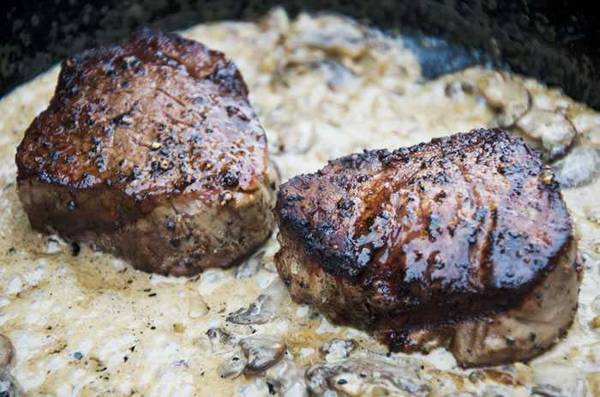What causes some beef to have a liver flavor? Occasionally you may have noticed that some steaks have an undertone flavor of liver. It is not something I like in a steak. So I asked our meat science advisor, Dr. Antonio Mata, what causes this phenomenon. He explained that there are several factors:
What causes some beef to have a liver flavor?
(a) Myoglobin is a protein that is very much a part of beef, and it is what causes juice to be pink (it is not blood). Myglobin contains iron, a metal that imparts metallic/livery flavors to a musles. The higher the myoglobin content the higher the probability that a given muscle will posses livery notes. Flat iron steaks contain high myoglobin and often show this condition.
(b) Intramuscular fat (marbling) counteracts livery notes upon cooking. So the higher the USDA quality grade the lower the probability of livery notes. For this reason ribeyes rarely exhibit the flavor and filets mignon frequently have the note.
(c) Wet aging of vacuum packed beef in plastic bags allows bacteria to produce lactic acid. There appears to be a synergistic effect between myoglobin and lactic acid that enhances liver notes. Says Mata “For this reason lean steaks like flat iron steaks should not be aged beyond 14 days.”
(d) Sensitivity to the flavor varies among individuals.
(e) Degree of doneness also seems to play a role. Normally a fan of medium rare, the scientist says “I prefer flat irons cooked to medium or medium well rather than medium rare. The liver notes get minimized and unlike most other muscles, tenderness is improved.”
I spoke with a large meat processor and he said it might also be the byproduct of the breed of cattle used. He thinks livery flavor is more frequent in meat from Holsteins, milk cows, that have been sent to the meat packer because they are not producing enough milk.
Mata adds “I do not know if the relative contribution of these factors on livery flavor has been studied. I doubt it, it would require an extensive, complex, costly investigation.”
How to deal with the liver flavor
First of all, if you’ve never tasted it then don’t worry about it. But if you find it frequently, then steer away from leaner cuts like filet mignon, flat iron, petite tenders, and select more marbled cuts like ribeye or strip steaks. For more about beef cuts, read this article. Also, select higher grades of meat because they tend to have more marbling: USDA Choice, USDA Prime, or Wagyu. For more about beef grades, click here.
Another technique is to cook the meat a little longer, up to about 135 to 140°F, where it is past red and more pink. Another technique is to make a sauce for it. The filets in the picture above were slowly grilled with smoke and then seared in a pan on the hot side of the grill. After searing I made a pan sauce with by wilting chopped shallots and chopped mushrooms in butter in the pan, deglazed with a splash of bourbon, whisked in a small amount of mustard, plenty of cream, and mounted the sauce after it thickened with more butter. Another good sauce for beef is a red wine sauce, a chimichurri, or a board sauce.



High quality websites are expensive to run. If you help us, we’ll pay you back bigtime with an ad-free experience and a lot of freebies!
Millions come to AmazingRibs.com every month for high quality tested recipes, tips on technique, science, mythbusting, product reviews, and inspiration. But it is expensive to run a website with more than 2,000 pages and we don’t have a big corporate partner to subsidize us.
Our most important source of sustenance is people who join our Pitmaster Club. But please don’t think of it as a donation. Members get MANY great benefits. We block all third-party ads, we give members free ebooks, magazines, interviews, webinars, more recipes, a monthly sweepstakes with prizes worth up to $2,000, discounts on products, and best of all a community of like-minded cooks free of flame wars. Click below to see all the benefits, take a free 30 day trial, and help keep this site alive.
Post comments and questions below
1) Please try the search box at the top of every page before you ask for help.
2) Try to post your question to the appropriate page.
3) Tell us everything we need to know to help such as the type of cooker and thermometer. Dial thermometers are often off by as much as 50°F so if you are not using a good digital thermometer we probably can’t help you with time and temp questions. Please read this article about thermometers.
4) If you are a member of the Pitmaster Club, your comments login is probably different.
5) Posts with links in them may not appear immediately.
Moderators